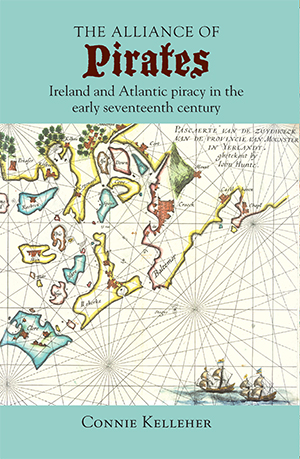THE ALLIANCE OF PIRATES: Ireland and Atlantic piracy in the early seventeenth century
Published in Book Reviews, Book Reviews, Issue 5 (September/October 2020), Reviews, Volume 28CONNIE KELLEHER
Cork University Press
€30
ISBN 9781782053651
Reviewed by Eamon Darcy
Eamon Darcy is a historian of early modern Ireland and Britain and lectures at Maynooth University.
 The image of swashbuckling pirates plundering ships with impunity is integral to the popular perception of the historical world of piracy. Yet, as Connie Kelleher’s excellent book, The alliance of pirates, shows us, piracy was a complicated business motivated by commercial gain that relied on the collaboration of locals and officials alike. It was also a way of life. In effect, Kelleher enriches our understanding of the clandestine and secretive nature of early modern piracy and its contact with the Munster coastline during ‘Ireland’s golden age of piracy’.
The image of swashbuckling pirates plundering ships with impunity is integral to the popular perception of the historical world of piracy. Yet, as Connie Kelleher’s excellent book, The alliance of pirates, shows us, piracy was a complicated business motivated by commercial gain that relied on the collaboration of locals and officials alike. It was also a way of life. In effect, Kelleher enriches our understanding of the clandestine and secretive nature of early modern piracy and its contact with the Munster coastline during ‘Ireland’s golden age of piracy’.
Two key characters who were involved in Irish and Atlantic piracy emerge in this book—Richard Bishop and Charles Howard, the first earl of Nottingham. Their stories are central to Kelleher’s overall argument. Bishop, the admiral of the so-called pirate alliance, allegedly commanded a 240-ton ship with 35 guns and a 120-man crew. He originally hailed from Yarmouth but settled in Skull in south-west Cork after English pirates were pushed westward by a clampdown on their activities by Queen Elizabeth I. Prior to the 1610s, Bishop sharpened his pirating skills off the coast of north-west Africa and the Mediterranean seaways. At times he co-ordinated the alliance’s individual leaders and commanders and guided their activities. Interestingly, Bishop had a residence in Crookhaven on land owned by one of the admiralty officers based in Munster, William Hull, whose tacit support allowed Bishop to operate. Effectively, the economic activities of this Atlantic alliance of pirates were facilitated by the collusion of prominent members of Munster society and the Stuart administration in England and Ireland. The earl of Nottingham, for example, was appointed lord admiral of England in May 1585. This gave him control of the English navy and judicial authority over English seas. After the succession of James VI and I to the English throne, Nottingham’s navies were not as well funded, prompting the lord admiral to take greater interest in the trials of pirates and the seizure of their pirated goods. It was suspected that Nottingham tolerated the Atlantic alliance’s activities in return for some of the booty they plundered. Such collusion and co-operation occurred at a micro-level in south Munster between ‘ordinary’ pirates and local officials, some of whom took a ‘cut’ of the seized goods. Even pirates who received a pardon for their activities in return for assisting Stuart authorities, like Bishop, still supported their former colleagues’ clandestine activities after securing their freedom. In this light, contemporary allegations that pirates acted without fear of prosecution are understandable. Such collaboration between pirates and the authorities facilitated their activities and gain in this golden age of Irish piracy.
One of the strengths of this volume is Kelleher’s treatment of the surviving evidence, which underpins an intimate sketch of pirate life within the Atlantic alliance. To this end Kelleher draws on a range of approaches. An agreement between English and Dutch authorities, for example, led to the drawing of a map by a Dutch cartographer of the Munster coastline. It provides visual clues to the key spaces the pirates used to evade capture and distribute their plunder. Topographical examination of these areas adds further nuance to contemporary beliefs that the coastline facilitated clandestine trading. Parts of Munster’s coastline resembled other pirate haunts such as Tortuga, a haven of eighteenth-century Caribbean piracy. As an archaeologist with the Underwater Archaeology Unit in the National Monuments Service, Kelleher brings a unique perspective to early modern Ireland through her investigations of wrecks off the Irish coast and of the cultural resonances that remain on land of pirate activity in the early seventeenth century. For example, a photograph of Dutchman’s Cove near Baltimore shows steps and platforms carved into rocks near the coast, complete with niches for lanterns, to facilitate a ship’s safe landing and the movement of its goods at night. Kelleher also focuses on traditional historical sources such as contemporary pamphlets and witness statements to tell us more about how pirates operated and collaborated with one another and how closely they interacted with local society (both native and newcomer alike). There are brief glimpses of the burgeoning Atlantic slave trade and of the role of women in local society, and the centrality of social ties fostered in the alehouse, providing interesting insights into daily life in early seventeenth-century society.
This fascinating book enriches our understanding of the maritime world of south and west Cork along with the more clandestine parts of the early modern Irish economy. Within its pages lie the range of activities in which pirates engaged, the alliances made and broken, strategies of success and survival, as well as interesting vignettes of daily life in the early seventeenth century. It is a ‘must read’ for local historians of Munster, and for historians of piracy, early modern Ireland and the Atlantic world.
















